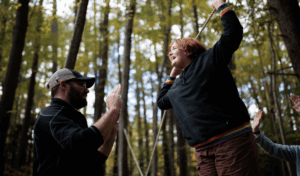Ever wonder why we rock babies to sleep, get dizzy when we spin, or find swinging in a hammock so relaxing?
All these activities engage our vestibular system. Although it is not commonly discussed, our vestibular system is one of our seven sensory systems (touch, smell, sight, hearing, taste, proprioception, and vestibular) and plays a vital role in our functionality from a physical, psychological, and social perspective. On the level of the body, our vestibular system helps us find a center of gravity, stay balanced, and feel grounded. From a psychological perspective, a well-functioning vestibular system helps support self-awareness, organized thinking, and stable sense of self. Due to its role in stabilizing the body and mind, it influences how we respond to our environment, including our social surroundings.
Engaging in activities that challenge the vestibular system and improve vestibular processing lead to higher levels of cognitive, emotional, and physical functioning. It is recommended that people of all ages get out to move their bodies and challenge their vestibular processing to achieve a general a sense of general well-being.
However, for the purpose of this hack, we want to equip you with ways to engage the vestibular system to quiet the mind and body during intense anxiety. Here a few simple ways to use vestibular input to soothe the nervous system:
- Rocking– use a rocking chair, office chair, or simply sway back and forth if it is socially appropriate to do so. Focus on slow, rhythmic, movement forward and backward.
- Swinging– set up a hammock, go to a playground, or swing on a porch swing. Focus on slow, linear movement, either front-to-back or side-to-side.
- Yoga– engage in slow, rhythmic movement that incorporate changes body and position, challenging one’s balance.
- Sit on an exercise ball or unstable surface– slowly bounce on an exercise ball or try to practice being still and balanced on an unstable surface such as a trampoline, balance board, or balance beam.
- Paced walking– walk in a slow rhythmic pattern of either back and forth, a circle, or a “figure 8” pattern.
- Ride a bike–focus on pedaling a slow, controlled, and consistent pace or bike in a circle or figure-8 pattern.


